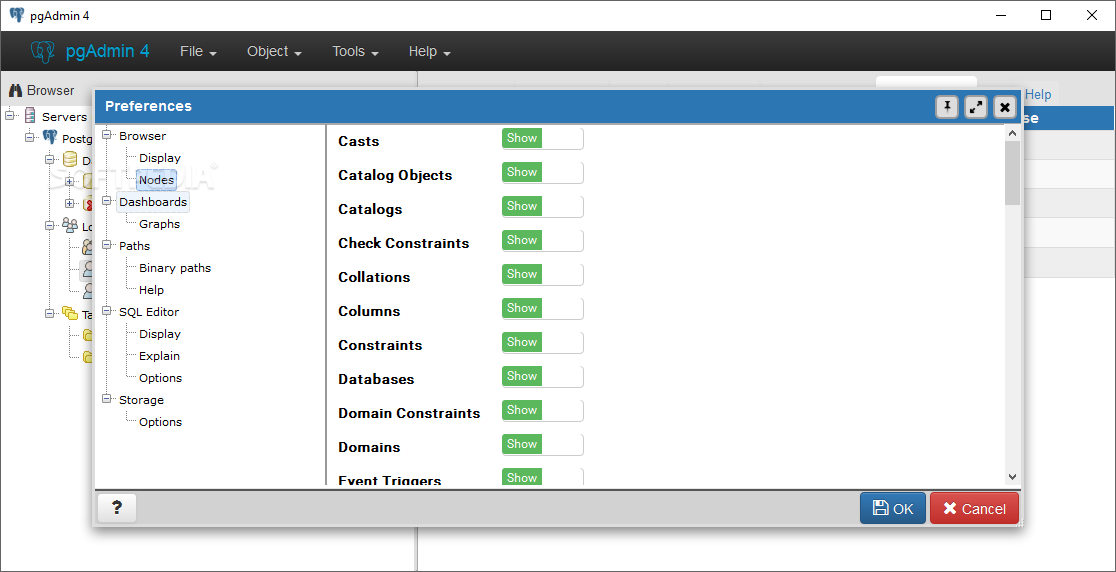

To access the Azure Database for the Postgres instance, we need to register the instance first.
PGADMIN 4 WINDOWS PASSWORD
Set up this password and then you would be able to access the home layout of this tool.Ĭlick on the Add New Server option from the quick links as shown above, which would bring up a dialog box as shown below. Setting up a master password provides one level of defense against such a situation. Generally, administrators use this tool, so unauthorized users who may attempt to access this tool can get undesired access to the database instance using the administrator’s credential (if the same is saved in the tool). When the tool is opened the very first time, it will prompt to configure a master password, since this tool can save connections and credentials that may readily connect to a database instance. Once pgAdmin 4 is installed, open the same and it would look as shown below.
PGADMIN 4 WINDOWS WINDOWS
In this article, we would be using the version of the tool that is installed on a Windows operating system.Ĭonnecting to Azure Database for PostgreSQL with pgAdmin 4Īfter pgAdmin 4 is installed, it now time to connect to the Azure Database for the Postgres instance that we created earlier. As shown below, one can select the version of the tool based on the Operating System or platform on which the tool is expected to be installed. This tool can be freely installed on the local machine from here. As of the draft of this article, the latest version of this tool is pgAdmin 4. The next part of our pre-requisite is installing the pgAdmin tool. Once the instance is created, you would be able to explore and administer this instance from the dashboard page of the instance, as shown below. Though this method of connecting would work with other modes of deployment as well, for simplicity purpose and to avoid and complexities in connecting to the database instance that may arise from using a different mode of deployment, we are using the Single Server mode for creating a new instance of Azure Database for PostgreSQL. Navigate to this service on the Azure portal and create an instance of the database using the Single Server deployment model. It is assumed that one has access to an Azure account with the required privileges to administer Azure Database for PostgreSQL server service. We intend to connect to an instance of Azure Database for PostgreSQL using pgAdmin, so the obvious pre-requisite to perform this exercise is creating an instance of the database as well as installing pgAdmin on a local workstation.
PGADMIN 4 WINDOWS HOW TO
Let’s go ahead and see how to connect to instances of Azure Database for PostgreSQL using the pgAdmin tool. One of the reasons possibly is since the most popular tool that is already used by PostgreSQL users for on-premise or cloud-hosted deployment is pgAdmin, users would prefer to continue using the same familiar tool to operate on instances of Azure Database for PostgreSQL on the Azure platform too. But there’s no specific tooling offering from Azure to operate on this database. Azure’s offering of PostgreSQL database on the Azure platform is Azure Database for PostgreSQL server. Likewise, the PostgreSQL database is one such open-source database type and one of the most popular management tools to operate on this database is pgAdmin.

Almost every type of user persona connects to SQL Server instances on-premises or on the cloud using SSMS to perform operations suited for their role. For example, one of the most popular management and operational tool for SQL Server is SQL Server Management Studio (SSMS).

In this article, we will show how to connect to instances of Azure Database for PostgreSQL servers using the pgAdmin tool installed locally on a user’s workstation.Įvery type of database has a community of data tools that facilitates management and operations on the database instances.


 0 kommentar(er)
0 kommentar(er)
